Yayoi Kusama – Retrospectives around the world in 2021
Hello everyone, I’m already back! This will be my last blog about Yayoi Kusama, which is about her exhibitions in London, New York and Berlin from 2021 to 2023.
To read the other two blogs about Kusama, please take a look at https://arthotshot.com/yayoi-kusama-contemporary-eccentric-multi-talented-japanese-gem-part-i/ and https://arthotshot.com/yayoi-kusama-important-solo-group-shows-1980s-2010s/.
Tate Modern, London
The first exhibition is still ongoing at the Tate Modern in London until June 2023. It shows two of Kusama’s Infinity Mirror Rooms.
Yayoi Kusama created her first mirror room called “Infinity Mirrored Room: Phallis Field” in New York in 1965. Since then her mirror rooms have become one of her trademarks.
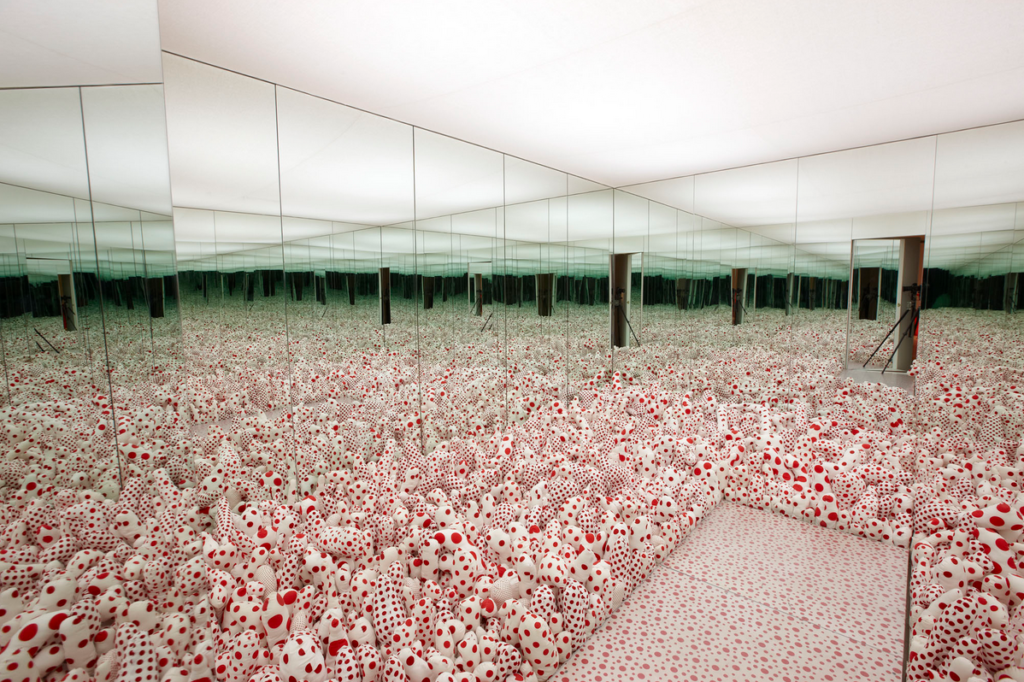
Image courtesy the artist, Yayoi Kusama Studio, Victoria Miro Gallery, London and Ota Fine Arts, Tokyo © the artist
Her first mirror room at the Tate is called “Infinity Mirrored Room – Filled with the Brilliance of Life” which was specifically made in 2011 for her retrospective in 2012 also at Tate Modern. Visitors pass through this room on a walkway made of mirrored tiles. The walls and ceiling are also mirrored, and a shallow pool of water covers the floor surrounding the walkway.

© Laetitia Grevers
The second mirror room is called “Chandelier of Grief” it creates the illusion of an infinite universe of rotating crystal chandeliers. The ceiling suspended baroque-style chandelier is the sole light source and through its rotating mechanism gives the viewers a destabilising yet fascinating effect.
Visitors are briefly immersed in the rooms as they have a magical and otherworldly feeling, hence they have become one of the artist’s most photographed artworks, giving them a high recognition value on Instagram.
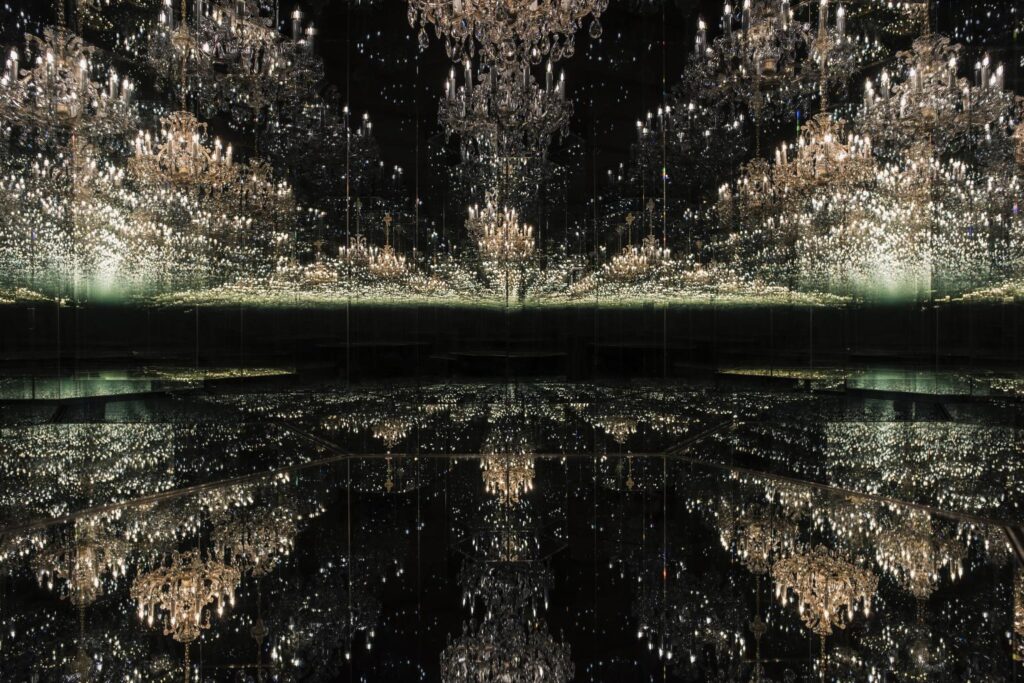
© https://www.tate.org.uk/art/artworks/kusama-chandelier-of-grief-t15202
If you have the time to visit this exhibition I would recommend it as these rooms always leave a lasting impression.
Botanical Gardens, New York
This exhibition which ran from April to October 2021 was called KUSAMA: Cosmic Nature, the curator was Mika Yoshitake.
The botanical garden was chosen as the location because nature is at the heart of Kusama’s work.
She grew up on a seed nursery surrounded by greenhouses and fields, therefore she was always exposed to the biological cycles of life and death. The artist developed a fascination about this and thus it became a prominent part of her work.
Eleven installations were chosen in consultation with the botanical garden. I will be showing only a few of them, especially the ones that have not yet been on public display.
One of the spaces used as an exhibition room was the greenhouse in the botanical gardens called “Flower Obsession“, it was inspired by the greenhouse Kusama grew up in.
Visitors were given 10 different coral coloured stickers with flowers as well as artificial gerbera daisies that they could glue on any surface of the greenhouse, turning it into a “flower garden”.

© Exhibition image of Yayoi Kusama’s Flower Obsession 2017 on display in NGV Triennial at NGV International 2017. Photo: Eugene Hyland
Another room similar to this one was her “Obliteration Room” which had the same concept but with polka dot stickers in a completely white room. This room was however not on display at the New York Botanical Gardens.

© https://www.theguardian.com/artanddesign/gallery/2012/feb/01/obliteration-room-yayoi-kusama-in-pictures
© Photograph: Stuart Addelsee/Rex Features/Ota Fine Arts, Tokyo
Kusama growing up in nature is also the reason she developed an interest in pumpkins.
Her grandfather walked with her through the fields and she remembers vividly when she first saw and touched a pumpkin. Kusama found it cute and grotesque at the same time and thought it had a bodily form. Her first impression still resonates with how she creates her pumpkins to this day.
Another reason she has a fascination with them is that she was asked to draw one for a whole month, while she trained in nihonga Japanese style painting at Kyoto university. The pumpkin drawing was supposed to be photorealistic, but Kusama got bored of academic training and started creating abstract and surrealistic artworks.
Dancing Pumpkin was also influenced by jellyfish and octopi, as their tentacles can move on their own. The sculpture gives off a similar vibe, showing each “leg” making its own movement.
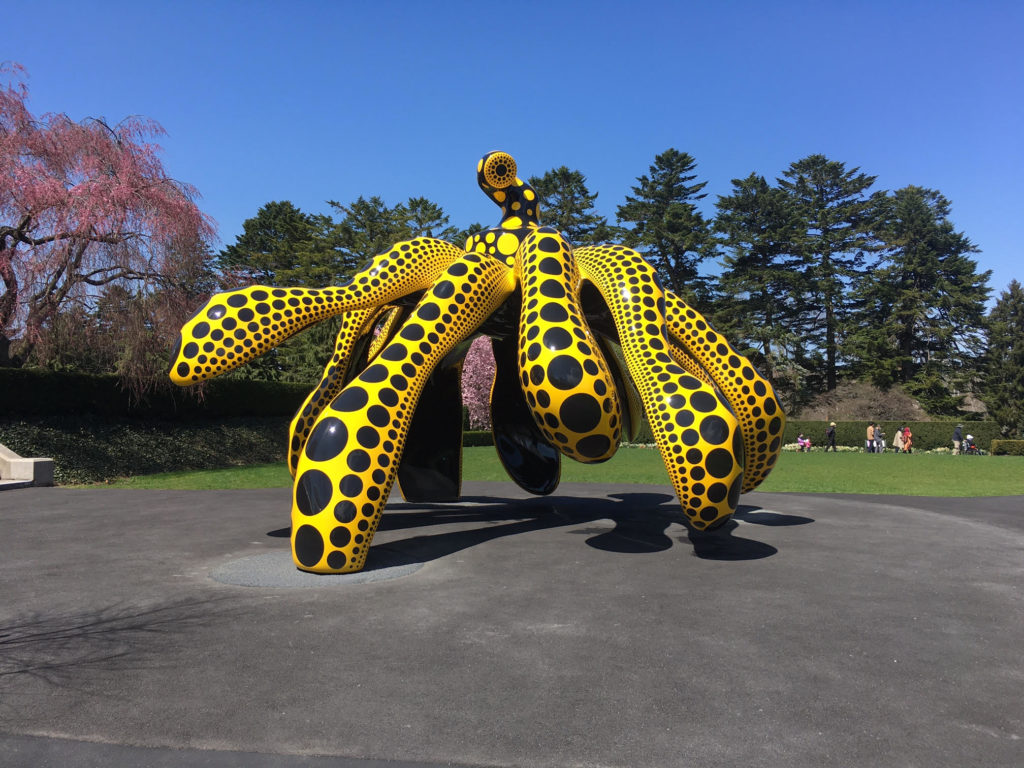
© “Dancing Pumpkin,” by Yayoi Kusama. Photo Everett Potter.
The artist was also mesmerised by not only blossoming flowers, but also their decaying buds.
She created “My Soul Blooms Forever” in 2019 and it was shown publicly for the first time during this exhibition. In this artwork the blossoming flowers are installed on a little pond in the New York Botanical Garden.

© Collection of the artist
https://www.designboom.com/art/yayoi-kusama-cosmic-nature-polka-dotted-trees-dancing-pumpkins-new-york-botanical-garden-04-08-2021/
Kusama’s work has anthropomorphic qualities as well, therefore giving some of her plants faces and lips. She has captured herself within these states of nature and talks through flowers, trees and more. This can also be seen through the work called “I Want to Fly to the Universe“, 2020.
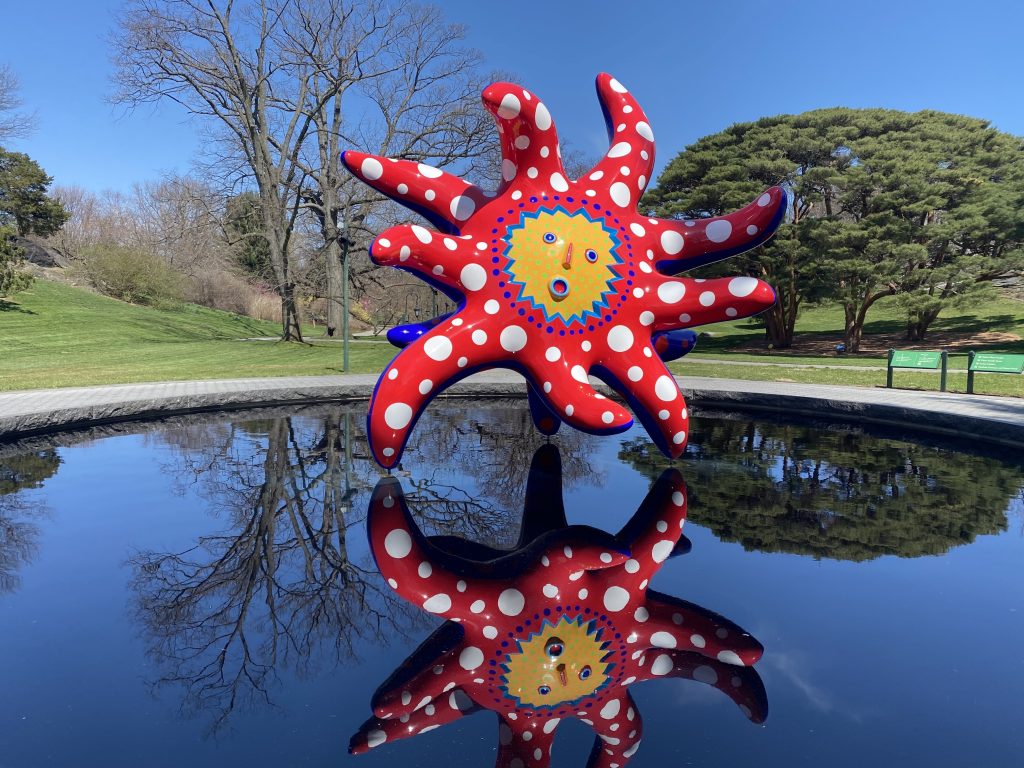
urethane paint on aluminum, 400 x 430 x 356 cm
© Collection of the artist
https://www.designboom.com/art/yayoi-kusama-cosmic-nature-polka-dotted-trees-dancing-pumpkins-new-york-botanical-garden-04-08-2021/
Kusama creates her works with the seasons, and the plants change accordingly, making her behave just like a horticulturalist. She is inspired by the meadows she comes across, although she does live in an urban environment, namely in a psychiatric hospital in Tokyo. She checked herself into this hospital in 1977 and has been living there ever since. Her studio is very close, she goes there daily.
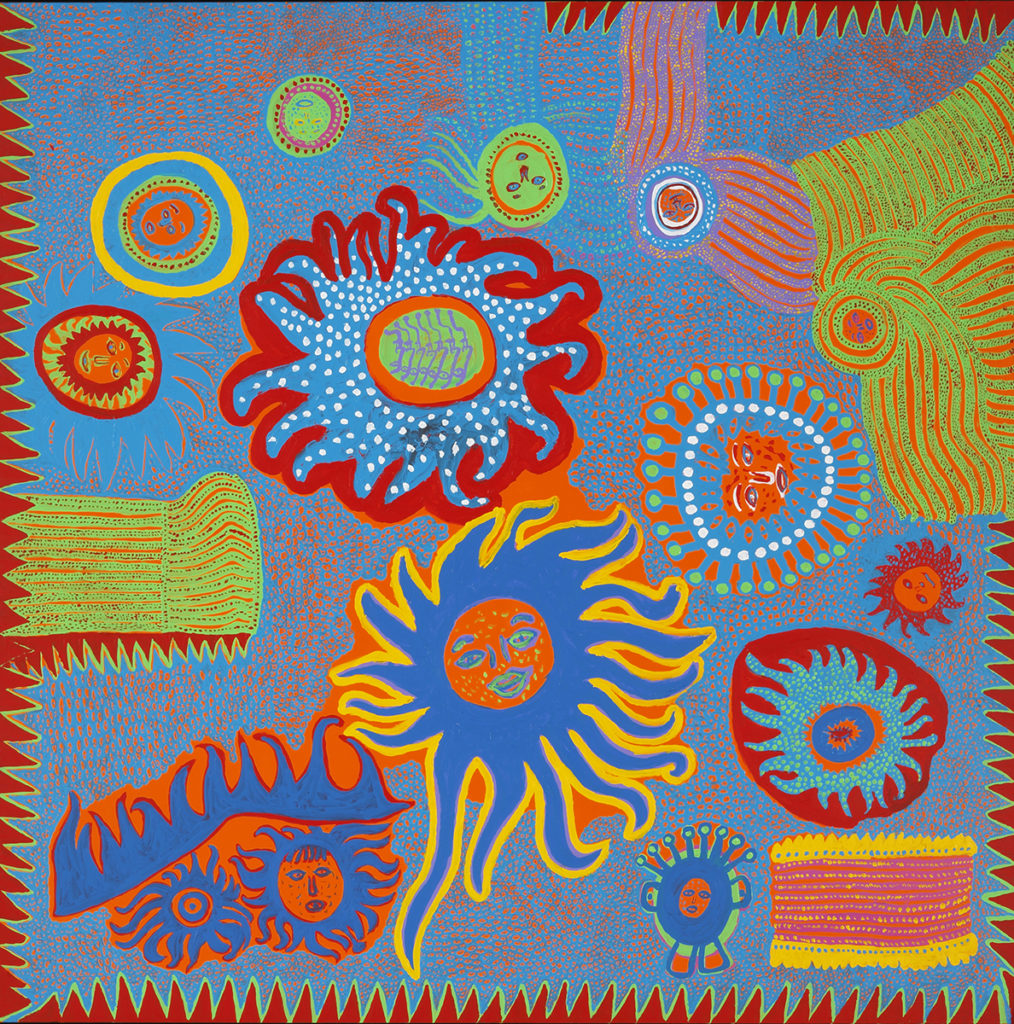
https://www.nybg.org/planttalk/a-message-from-yayoi-kusama/
Collection of the artist
Courtesy of Ota Fine Arts, Victoria Miro, and David Zwirner
Martin Gropius Bau Berlin
The exhibition “Yayoi Kusama: Eine Retrospektive“, curated by Stephanie Rosenthal, was on show at the Martin Gropius Bau from April to August 2021.
The show traces key creative periods from over 70 years on almost 3000 m² and includes a number of recent works, including a new Infinity Mirror Room.
A key point of the retrospective was to follow the development of Kusama’s work from her early paintings, her many sculptures and her experiential spaces.
Another important aspect is Kusama’s representation in Germany and Europe, her work had been shown but never in a contextualised manner. Therefore, this exhibition is a prime step for the artist’s presentation in Europe and her first extensive retrospective in Germany.
The exhibition is presented from the artist’s perspective and shown in a chronological order starting with her early works and ending with her latest ones. There are also focus rooms which display some of Kusama’s former exhibitions, like With All My Love For The Tulips, I pray Forever.

© https://www.pinterest.de/marijameme/art-world/
Her exhibition can be seen as a walk through art history, as she played a meaningful part in it.
Kusama was one of the first artists to perform in front of the public, and a fashion designer who explored the erotic side of dresses; meaning she crossed borders between different art forms, unfortunately she didn’t get enough recognition for it. This, however, led the artist into finding new ways of expressing herself which were then also transferred to her artworks.

©https://www.pinterest.de/pin/436427020126519573/
From the mid- to the late 1960s and late 1970s Kusama had a lot of contact in Europe. She was asked to have her first solo shows in Germany and moved to Gelsenkirchen in 1966. This was an artists village. She had several exhibitions in the Ruhr region, including at the Galerie Thelen in Essen.

© https://ada-invitations.de/cpt-einladungen/yayoi-kusama-driving-image-show-galerie-thelen-essen-1966/
While Kusama was in Düsseldorf in 1960 she met Lucio Fontana for the first time. She returned to Europe in the mid-1960s, where she worked at his studio with him in Italy; this resulted in both artists presenting 1,500 reflecting spheres at the Venice Biennale (without permission). They could be bought at $2 a piece by the visitors.

© https://www.dazeddigital.com/art-photography/article/40416/1/yayoi-kusama-recreate-1966-narcissus-garden-new-york-moma-ps1
Installing “Yayoi Kusama: Eine Retrospektive” was a challenge as it took place during Covid-19 times, leading to include some works which weren’t planned to become part of the final exhibition. It was also difficult as the museum expected a huge amount of visitors, that had to be limited per time slot.

© YAYOI KUSAMA, Courtesy: Ota Fine Arts
The new work „A Bouquet of Love I Saw in the Universe“ was especially made for this exhibition and installed in the atrium of the museum. The installation has 16 tentacles which were all hand sown. The latex looks very visceral giving the impression that it is alive and the highest tentacle has a height of 11 metres.

© https://www.berlin.de/ausstellungen/archiv/5967973-3238788-yayoi-kusama.html
I hope you’ve enjoyed this blog and learned a lot about Yayoi Kusama. Until then!
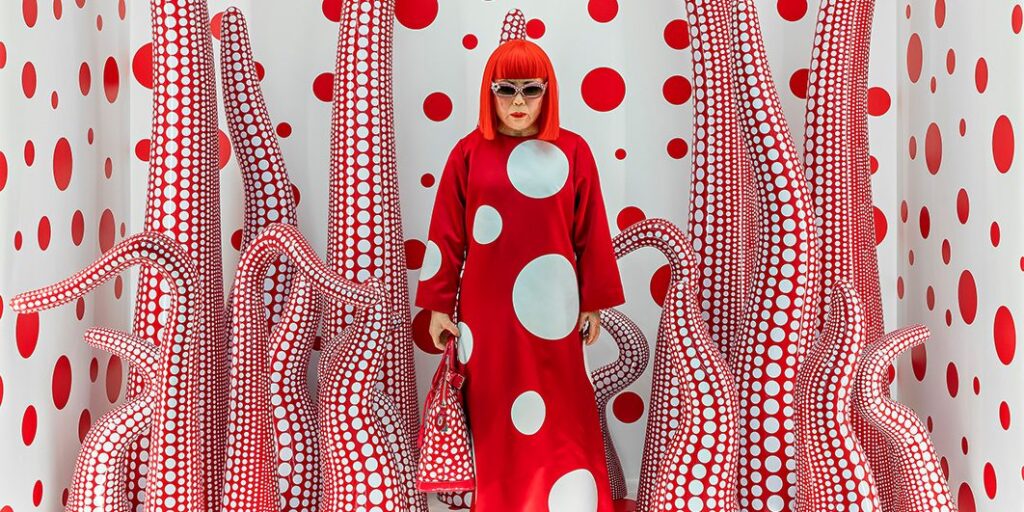
© https://globalgoodness.ca/yayoi-kusama-art/
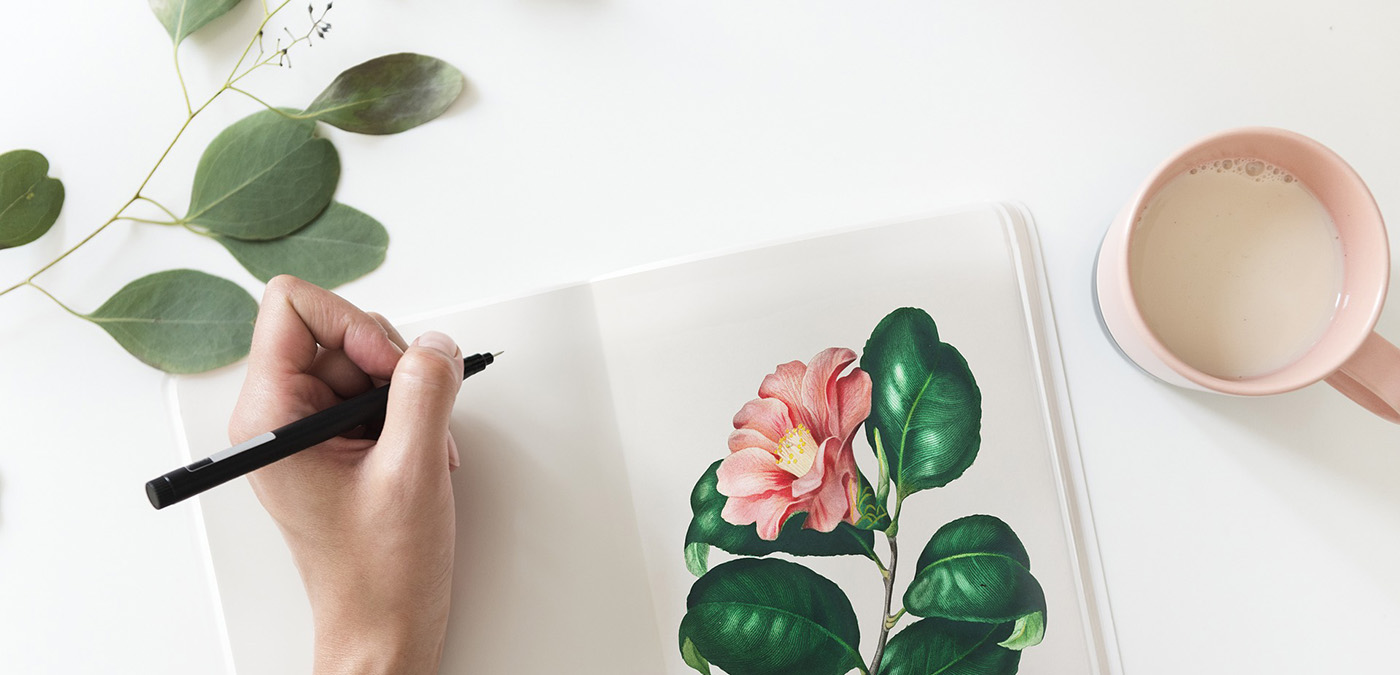
-
-
2 years
Tagged #Bucharest, #contemporaryart, #museumofrecentart, #nationalhistorymuseumromania, #nationalmuseumromania